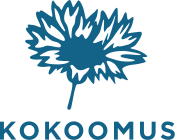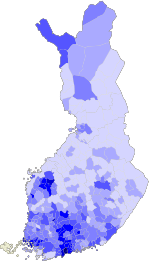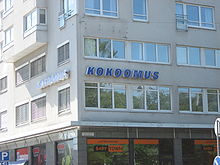- National Coalition Party
-
National Coalition Party 
Finnish name Kansallinen Kokoomus r.p. Swedish name Samlingspartiet r.p. Leader Jyrki Katainen Founded 1918 Headquarters Pohjoinen Rautatiekatu 21 B
FI-00100 HELSINKI
FINLANDMembership (2011) 41,000[1] Ideology Pro-Europeanism, Liberalism[2][3] Political position Centre-Right International affiliation International Democrat Union European affiliation European People's Party European Parliament Group European People's Party Official colours Blue Parliament 44 / 200European Parliament 3 / 13Municipalities 2,020 / 10,412Website www.kokoomus.fi Politics of Finland
Political parties
ElectionsTurku office of the National Coalition Party.
The National Coalition Party (Finnish: Kansallinen Kokoomus r.p., Kok.; Swedish: Samlingspartiet r.p., Saml.) is a liberal conservative[4] political party in Finland founded in 1918.
The National Coalition Party is one of the four largest parties in Finland, along with the Social Democratic Party, the Centre Party and the True Finns. The party bases its politics on "individual freedom and responsibility, equality, Western democracy and economic system, humane principles and caring."[5] The party is strongly pro-European and is a member of the European People's Party (EPP).
Its vote share has been around 20% in parliamentary elections in the 1990s and 2000s. It won 44 out of 200 seats in the parliamentary elections of 2011, becoming the largest party in the Finnish parliament for the first time in its history.[6] On communal level it had become the most popular party already in 2008.
Contents
Ideology and voter base
According to itself the National Coalition Party wants to build "a society where a person’s own choices, hopes and needs set the direction for development."[7]
The party defends "individual freedom and promote people’s opportunities to make choices, but without ignoring everyone’s responsibility for one’s own life, fellowmen and the environment. Our ideology combines freedom with responsibility, democracy and equality".[7] The party's basic values are education, tolerance, rewarding and caring.[7]
The party has several political currents. In international affairs, the party has viewed the European Union in much more positive terms than any other party.[citation needed] It is also supportive of seeking membership in the North Atlantic Treaty Organization. The party wants to build "economically and politically stronger European Union, we envisage an EU that is a more effective and a more prominent actor in world politics".[7]
Polls show that as of 2008, the National Coalition Party is the party that has been viewed most positively by Finns[8] and its membership has been on the rise.[9] Out of the major parties, the National Coalition Party has the highest proportion of women (2005 statistics)[10] and is the most favored party among young generations (2008 statistics).[11]
The party has strongest support on cities in Southern Finland and is popular among entrepreneurs, although not associating in any particular social group.
Organisation
People can join various member organizations in the party.
Student Union of National Coalition (Finnish: Kokoomusopiskelijat Tuhatkunta, Swedish: Samlingspartiets Studerandeförbund Tuhatkunta) is the largest political student's movement in Finland.[12][13]
The party's Women's League (Kokoomuksen Naisten Liitto/Samlingspartiets Kvinnoförbund, or shortly Kokoomusnaiset) brings women together and focuses on improving gender equality in Finland and around the world. It believes that "women and men must have the same opportunities and rights to come to life, grow up, receive education, participate, work and care".[14]
The Swedish-language activities are organised by the Centre-right Coalition in Finland (Borgerlig samling i Finland, BiF).
Many immigrants have joined the National Immigrants (Finnish: Kansalliset Maahanmuuttajat, Kamut), an immigrant group led by Turkish-born Hülya Kytö from Turku.[15]
History
The party was founded December 9, 1918, after the Finnish Civil War, by the majority of the Finnish Party and the minority of the Young Finnish Party supporting monarchy.[16] (The previous day the republicans of both parties had founded the National Progressive Party.[17]) The founding meeting declared, "A national coalition is needed over old party lines that have lost meaning and have too long separated similarly thinking citizens. This coalition's grand task must be to work to strengthen in our nation the forces that maintain society. Lawful societal order must be strictly upheld and there must be no compromise with revolutionary aspirations. But simultaneously determined constructive reform work must be pursued."[18] The party sought to accomplish this by advocating constitutional monarchy and, failing that, strong governmental powers within a republican framework; and by implementing a number of social and economic reforms, such as compulsory education, universal health care, and progressive income and property taxation.[19]
In the late 1920s and early 1930s the threat posed by the Joseph Stalin's communist Soviet Union influenced Finnish politics. Communists, backed by Soviet leaders, accelerated their activities. Although Pehr Evind Svinhufvud, the party's first President, played a key role in halting the Lapua Movement, in the 1933 parliamentary election the party formed an electoral coalition with Patriotic People's Movement, founded by former Lapua Movement supporters. The result was a major defeat. The party lost 24 of its previous 42 seats in the parliament. It made a break with the Patriotic People's Movement in 1934 under the newly elected chairman J.K. Paasikivi. Nevertheless it was shut out of government until the outbreak of the Winter War and only slowly gained back support.[20] During both the Winter War and the Continuation War, the party took part in unity governments and generally strongly supported government policies. After the war the National Coalition Party sought to portray itself as defender of democracy against the resurgent Finnish communists. Paasikivi, who had advocated making more concessions to Soviet Union before the Winter War and taken a cautious line with regard to cooperation with Germany before the Continuation War, acted first as Prime Minister (1944–1946) and then as President (1946–1956). The conflict between the party and the communist Finnish People's Democratic League culminated when President Paasikivi fired the Communist Minister of the Interior Yrjö Leino, who had used the security police to spy on the party's youth organization among other abuses.[21][22]
In 1951 the party changed its name from the original Kansallinen Kokoomuspuolue to the current Kansallinen Kokoomus. The 1950s were also a time of ideological reform, as emphasis on individual liberty and free market reforms increased at the expense of social conservatism and maintaining a strong government. A minor division in 1958 led to the formation of the Christian Democrats.
From 1966 to 1987 the party was shut out of government. By criticizing President Urho Kekkonen and Finnish communists, the party had lost the President's trust and governments based on the Centre Party and left-wing parties followed one another. A new guard emerged within the party in the 1970s that sought to improve relations with President Kekkonen. Their work was partially successful in the late 1970s.[23] However, even though the party supported Kekkonen for president in 1978 and became the second biggest party in the country in the 1979 parliamentary election, a place in the government continued to elude it until the end of Kekkonen's time in office.
During the long years in opposition the party's support had grown steadily and in 1987 it attained the best parliamentary election result in its history. Harri Holkeri became the party's first Prime Minister since Paasikivi. During Holkeri's time in office, the Finnish economy suffered a downturn, precipitated by a coincidence of factors, and the 1991 parliamentary election resulted in a loss. The party continued in the government as a junior partner until the 2003 parliamentary election, after which it spent four years in the opposition.
In 1990, the Youth Union of National Coalition was the first significant political organization in Finland to publicly advocate membership in the European Union.[24]
The current party chairman is Jyrki Katainen, who was elected in 2004. In March 2006, Katainen was elected Vice-President of the European People's Party (EPP). He is seen as a dynamic and reforming person by many party members although there have been some doubts in the Finnish media about his lack of experience and relatively young age (born in 1971). The previous party chairman is Ville Itälä, who was elected as a Member of the European Parliament after his term in office in 2003.
The National Coalition Party's candidate in the 2006 Finnish presidential election was former Minister of Finance and ex-party chairman Sauli Niinistö. He qualified for the second round runoff as one of the top two candidates in the first round, but was defeated by the incumbent Tarja Halonen with 51.8% of the vote against his 48.2%.
Latest elections
 Support for the National Coalition Party by municipality in the 2011 parliamentary election. The party has traditionally fared well in large urban areas, such as those around Helsinki, Tampere and Turku. The party's strongest municipality was the city of Espoo, where the NCP received 40 per cent of the vote.
Support for the National Coalition Party by municipality in the 2011 parliamentary election. The party has traditionally fared well in large urban areas, such as those around Helsinki, Tampere and Turku. The party's strongest municipality was the city of Espoo, where the NCP received 40 per cent of the vote.
The National Coalition Party had been in the opposition since the 2003 parliamentary election, in which it suffered a defeat, getting only 18.6% of the votes and losing six seats to bring its total down to 40. (It later gained two seats through defections.) In the 2007 parliamentary election the party increased its share to 50 seats in what was the biggest gain of the election. The party held a close second place in the Parliament after the Centre Party, which had 51 seats. The Social Democratic Party were third with 45 seats. After the election the party entered into a coalition government together with the Centre Party, the Green League, and the Swedish People's Party. The NCP got important portfolios, including those of Finance and Foreign Affairs.
In the 2011 parliamentary election the party came first place for the first time in history with 44 seats, despite losing six seats. After lengthy negotiations party chairman Jyrki Katainen became Prime Minister in a six-party coalition government, which includes parties from left to right.
Election results
Parliament

Parliamentary elections Year MPs Votes 1919 28 151 018 15,71 % 1922 35 157 116 18,15 % 1924 38 166 880 18,99 % 1927 34 161 450 17,74 % 1929 28 138 008 14,51 % 1930 42 203 958 18,05 % 1933 18 187 527 16,93 % 1936 20 121 619 10,36 % 1939 25 176 215 13,58 % 1945 28 255 394 15,04 % 1948 33 320 366 17,04 % 1951 28 264 044 14,57 % 1954 24 257 025 12,80 % 1958 29 297 094 15,28 % Year MPs Votes 1962 32 346 638 15,06 % 1966 26 326 928 13,79 % 1970 37 457 582 18,05 % 1972 34 453 434 17,59 % 1975 35 505 145 18,37 % 1979 47 626 764 21,65 % 1983 44 659 078 22,12 % 1987 53 666 236 23,13 % 1991 40 526 487 19,31 % 1995 39 497 624 17,89 % 1999 46 563 835 21,03 % 2003 40 517 904 18,55 % 2007 50 616 841 22,26 % 2011 44 598 369 20,44 % European parliament
Year MEPs Votes 1996 4 453 729 20,17 % 1999 4 313 960 25,27 % 2004 4 392 771 23,71 % 2009 3 386 416 23,21 % Municipal
Year Councillors Votes 1950 88 159 5,85 % 1953 133 626 7,59 % 1956 105 220 6,29 % 1960 275 560 14,04 % 1964 213 378 10,0 % 1968 1 388 364 428 16,09 % 1972 1 503 451 484 18,06 % 1976 2 047 561 121 20,92 % 1980 2 373 628 950 22,94 % 1984 2 423 619 264 22,96 % 1988 2 392 601 468 22,87 % 1992 2 009 507 574 19,05 % 1996 2 167 514 313 21,64 % 2000 2 028 463 493 20,84 % 2004 2 078 521 412 21,83 % 2008 2 020 597 727 23,45 % List of party Chairmen
- Hugo Suolahti (1918–1919)
- Eemil Nestor Setälä (1920)
- Antti Tulenheimo (1921–1924)
- Hugo Suolahti (1925)
- Kyösti Haataja (1926–1932)
- Paavo Virkkunen (1932–1933)
- Juho Kusti Paasikivi (1934–1936)
- Pekka Pennanen (1936–1942)
- Edwin Linkomies (1943–1944)
- K. F. Lehtonen (1945)
- Arvo Salminen (1946–1954)
- Jussi Saukkonen (1955–1965)
- Juha Rihtniemi (1965–1971)
- Harri Holkeri (1971–1979)
- Ilkka Suominen (1979–1991)
- Pertti Salolainen (1991–1994)
- Sauli Niinistö (1994–2001)
- Ville Itälä (2001–2004)
- Jyrki Katainen (2004–)
Prominent party leaders
- Lauri Ingman – Prime Minister of Finland 1918–1919 and 1924–1925
- Antti Tulenheimo – Prime Minister of Finland 1925
- Pehr Evind Svinhufvud – President of Finland 1931–1937
- Edwin Linkomies – Prime Minister of Finland 1943–1944
- Juho Kusti Paasikivi – President of Finland 1946–1956, Prime Minister of Finland 1944–1946
- Harri Holkeri – Prime Minister of Finland 1987–1991
- Sauli Niinistö – Minister of Finance of Finland 1995–2003, Speaker of the Parliament of Finland 2007–2011
- Jyrki Katainen - Minister of Finance of Finland 2007-2011, Prime Minister of Finland 2011-
References
- ^ Niemelä, Mikko (13 March 2011). "Perussuomalaisilla hurja tahti: "Jäseniä tulee ovista ja ikkunoista"". Kauppalehti. http://www.kauppalehti.fi/5/i/talous/uutiset/etusivu/uutinen.jsp?oid=20110364985&ext=rss. Retrieved 20 April 2011.
- ^ Muukkonen, Matti (12 September 2005). "Kokoomus konservatismista liberalismiin". http://arkisto.kokoomus.net/mp/db/file_library/x/IMG/11500/file/MattiMuukkosenPTA30-v.pdf. Retrieved 24 July 2011.
- ^ "Kyllä se linja, jota meidän puolueen puheenjohtaja Jyrki Katainen vetää, on yksiselitteisen liberaali. Se panostaa monikulttuurisuuteen, suhtautuu myönteisesti maahanmuuttoon ja ylipäätään kansainvälisyyteen" ("The policy led by our party's chairman Jyrki Katainen is unambiguously liberal. It invests in multiculturalism, takes a positive attitude toward immigration and toward internationalism in general.") Interview of Alexander Stubb, then Foreign Minister. YLE TV 1: Puolueet koolla: Kokoomus. Aired 12 June 2010.
- ^ Wolfram Nordsieck. "Parties and Elections in Europe". Parties-and-elections.de. http://www.parties-and-elections.de/finland.html. Retrieved 2011-04-18.
- ^ Official website (2007): Tätä on Kokoomus.
- ^ National coalition party « Svenskfinland in English
- ^ a b c d Official website in June 2009
- ^ Tutkimus: Kokoomus saa puolueista eniten myönteisyyttä. Uusi Suomi. 18.9.2008
- ^ 16:42 (2008-02-08). "Kokoomus, vihreät ja perussuomalaiset kasvattavat jäsenmääriään - HS.fi - Politiikka". HS.fi. http://www.hs.fi/politiikka/artikkeli/Kokoomus+vihre%C3%A4t+ja+perussuomalaiset+kasvattavat+j%C3%A4senm%C3%A4%C3%A4ri%C3%A4%C3%A4n/1135238302741. Retrieved 2011-04-18.
- ^ HS: Suurissa puolueissa miesenemmistö Turun Sanomat 18.9.2005
- ^ Kokoomus ja vihreät kirivät nuorten suosioon[dead link]
- ^ "Student Union of National Coalition Party (Tuhatkunta)". Tuhatkunta.fi. http://www.tuhatkunta.fi/index.php?option=com_content&task=view&id=25&Itemid=. Retrieved 2011-04-18.
- ^ Kokoomusopiskelijoiden tavoiteohjelma 2008–2009
- ^ "Tervetuloa Kokoomuksen Naisten Liittoon!". Kokoomusnaiset.fi. 2008-09-18. http://www.kokoomusnaiset.fi/keita+me+olemme/organisaatio/. Retrieved 2011-04-18.
- ^ "Järjestörekisteri". Kansainvalisyyskasvatus.net. http://www.kansainvalisyyskasvatus.net/jarjestorekisteri/1283. Retrieved 2011-04-18.
- ^ Kansallinen Kokoomuspuolue perustetaan.
- ^ "''Suomalainen puoluehistoria''". http://www.soc.utu.fi/laitokset/poliittinenhistoria/opiskelu/Suomalainenpuoluehistoria21012009.ppt. Retrieved 2011-04-18.
- ^ Kansallisen Kokoomuspuolueen perustava kokous (1918): Kansalaisille.
- ^ Kansallisen Kokoomuspuolueen ohjelma. February 2, 1919.
- ^ Ilkka Ahtokivi (1996): Kokoomus itsenäisessä Suomessa 1918–44.
- ^ Ilkka Ahtokivi (1996): Kokoomus Valpon silmätikkuna. Nykypäivä. May 17, 1996.
- ^ Kokoomus piikkinä lihassa. Kokoomus
- ^ Tomi Tuomisalo (2006): Kokoomus, Kekkonen ja NKP:n luottamus. Kansallisen Kokoomuksen toiminta hallitusaseman saavuttamiseksi 1969–1981. Helsingin Yliopisto.
- ^ Vares, Vesa: Kaksi askelta edellä, page 298.
External links
- National Coalition Party – Official site (Finnish)
- Youth Union of National Coalition (Finnish)
- Student Union of National Coalition (Finnish)
- National Coalition Party Women (Finnish)
- Party's news and announcement paper (Finnish)
- European People's Party official site
 Political parties in Finland
Political parties in FinlandMPs in parliament National Coalition Party (44) · Social Democratic Party of Finland (42) · True Finns (39) · Centre Party (35) · Left Alliance (14) · Green League (10) · Swedish People's Party of Finland (9+1) · Christian Democrats (6)Other Independence Party · For The Poor · Workers Party of Finland · Pirate Party · Change 2011 · Freedom PartyUnregistered parties Communist Party of Finland · Finnish Seniors' Party · Communist Workers' Party – For Peace and Socialism · Finnish Islamic PartyCategories:- Liberal-conservative parties
- Political parties in Finland
- International Democrat Union member parties
- Political parties established in 1918
- 1918 establishments in Finland
- Conservatism in Finland
Wikimedia Foundation. 2010.

